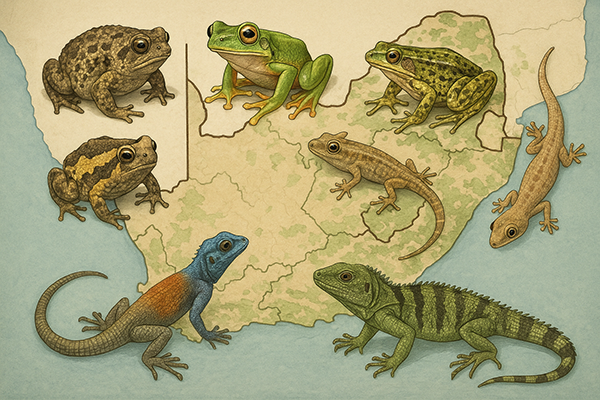-
Researchers have created a comprehensive list of indigenous names for frogs and reptiles in order to promote inclusive conservation
-
People are far more likely to protect what they can name
-
South Africa’s indigenous languages have long been marginalised in science
-
The inclusion of indigenous names in biodiversity literature is not only good science, but also democratic
Frogs, snakes and lizards rarely take centre stage in the worlds of language policy and biodiversity, but then again, South Africa is no ordinary place. A new study published in the African Journal of Herpetology offers a compelling insight into how indigenous knowledge and scientific taxonomy can coexist to make conservation truly inclusive and effective.
The study, titled Naming South African frogs and reptiles in nine indigenous languages, is a multilingual feat led by Dr Fortunate Phaka of the North-West University (NWU), alongside collaborators from Belgium and across South Africa. It addresses a significant yet overlooked issue in South African science: the near-total absence of frogs and reptiles named in the country's nine official indigenous languages.
The problem is more than linguistic. Scientific names, which are often in Latin or Greek, are intended to be consistent across the globe, but they are largely incomprehensible to the local communities who live among the species and who are often central to their conservation. This disconnect can be more than a minor inconvenience, it can result in miscommunication, poor policy implementation, and a general lack of public engagement with biodiversity efforts.
Phaka's research is groundbreaking in both scope and intent. Using online surveys, social media outreach and field interviews, the team compiled a list of over 4 800 indigenous names for all 543 species of frogs and reptiles officially recognised in South Africa, extending the names originally used to group multiple species together. These names span the country’s linguistic diversity and include languages such as isiZulu, Xitsonga, isiNdebele and Tshivenda. Where no specific name for a species existed, the researchers created new names based on familiar descriptive traits, as scientists do with newly discovered organisms.
Why does this matter? Firstly, it makes conservation more accessible. People are far more likely to protect things they can name, especially if those names are rooted in their own language and cultural understanding. For example, a Xitsonga speaker may not relate to the scientific name Ptychadena anchietae, but the name “Mabhruku”, inspired by the frog’s long legs and springy leap, may inspire a different kind of curiosity and care.
Moreover, the research reveals that indigenous naming systems often reflect an intuitive ecological logic. For instance, the Xhosa and Zulu words Ixoxo and Isele group frogs based on the texture of their skin. While not strictly scientific, this classification still captures a meaningful distinction. This folk taxonomy often aligns with scientific classifications at higher taxonomic levels (family or genus), though rarely at the species level. The mismatch, or “under-differentiation”, as the authors describe it, is not due to a lack of insight, but rather reflects the observational priorities of communities whose engagement with these animals is shaped by cultural, utilitarian or ecological familiarity.
The implications stretch beyond taxonomy into social justice and language policy. South Africa’s indigenous languages have long been marginalised in science, a space still dominated by English and, to a lesser extent, Afrikaans. As Phaka argues, including indigenous names in biodiversity literature is not only good science, but also democratic. It enables speakers of these languages to engage with conservation as informed contributors rather than passive recipients. In short, it is a step towards epistemic equity.
The fact that this project emerged from a collaboration between the North-West University and international institutions such as Hasselt University speaks to the global relevance of local knowledge. While the frogs and reptiles are mostly endemic to South Africa, the model of integrating folk and formal taxonomies and embedding local languages in scientific discourse is exportable. Countries ranging from Brazil to Pakistan have grappled with similar issues, and Phaka’s work could serve as a valuable template.
There is still work to be done. Why do some species have names, while others don’t? What role do cultural taboos, visibility, and perceived usefulness play in shaping folk taxonomy? These are questions for future research. In the meantime, however, the simple act of naming a frog, lizard or snake in a language that has endured generations is a profound act of cultural and scientific synthesis.
Ultimately, it turns out that what you call a frog does matter. Especially when that name could be the key to saving the species.
• Dr Fortunate Phaka can be contacted at 071 463 6065 and mafetap@gmail.com.

